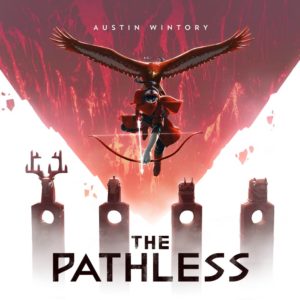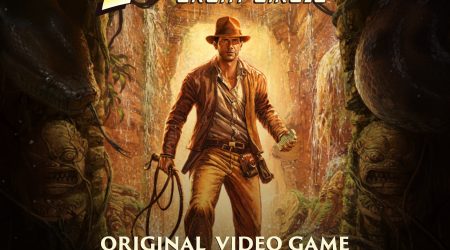
After ABZÛ, The Pathless is the second video game from game studio Giant Squid. Creative director and founder Matt Nava has already built quite a reputation at Thatgamecompany as art director for the game Journey. What ABZÛ and Journey have in common are magnificent storytelling, game design and world-building seen through the eyes of a single character traversing the world. What both also share is that their music has been written by Austin Wintory, who has done a fantastic job on the music for both games. I consider Journey one of the best gaming soundtracks, making me quite curious about what kind of music Wintory has written for The Pathless.
Before we get into more details about the game and how the music is used in it, we have to discuss the main theme first, because I consider that one of Wintory’s strong suits. Most of the time Wintory uses a simple melody in the main theme for this type of game, and that is also the case for The Pathless, as can be heard in the first track “None Have Returned.” In addition to the gorgeous melody, there is also a very clever choice of instruments, which is a common theme throughout the whole score. In addition to a nyckelharpa, which is an instrument originating from Sweden, playing the main melody, there is also a prominent role for Tuvan throat singing by The Alash Ensemble. More amazing ethnic folk instruments from different parts in the world, including wooden flutes, lutes, ouds, a viola da gamba and many more, can not only be heard on the first track, but across the entire score. There are some orchestral elements, but, except for the French horns, they are not that prominent, something I will address later in this review.
According to Wintory’s videos, his aim with using all these different folk instruments was to create music that sounds like it is coming from everywhere and from nowhere at the same time. This may seem a little contradictory, but it makes sense when you consider that each instrument sounds familiar on its own, but the unusual combination makes them unfamiliar, since you are hearing the sounds in a different setting.

One of Wintory’s strengths in addition to creating gorgeous main themes, is coming up with music that is perfectly suited for the gameplay and the world the player is in. The game is about a hunter, who travels to an island to try to lift an ancient curse. She and her trusty eagle are introduced in the tracks “None Have Returned,” “A Shroud over the World” and “Gateway,” containing beautiful versions of the main theme and other melodies using the folk instruments. After the introduction, the core of the game starts, consisting of four large gameplay loops, before the end game begins. Each gameplay loop consists of the hunter exploring a part of the island and solving puzzles using her eagle and her bow. After solving all the puzzles in one of the parts, she has to chase and fight a huge flaming spirit beast. When the battle is over, the hunter cleanses the beast from evil, restoring it into its true and gentle form. The player then has to repeat this gameplay loop in a new area of the island.
This gameplay loop is reflected very well in the music on this album. Each one starts with the exploration part using ambient and atmospheric music, as can be heard in “From the Antlers,” “The Redwood Steppe,” “The Plains” and “Into the Mountains,” each containing elegant melodies from different instruments, accompanying the hunter on her quest. The music for the beast fights can be heard in “Cernos,” “Sauro,” “Nimue” and “Kumo,” and they include the whole fight sequence, from the chase to the cleansing at the end. The clever thing Wintory has done is that one specific instrument is dominant in each gameplay loop and these can be heard in the battle music very well. In “Cernos” it is the oud, the double bass is dominant in “Sauro,” in “Nimue” a bamboo flute can be heard a lot, and in “Kumo” the main focus is on the bass clarinet, but these instruments are also present in the exploration music of the same loop, albeit less prominently.
When I listened to the boss battle music for the first time, I was quite surprised by how melodic the music was for such a dark sequence. The music is fast, with all kinds of rapid patterns, but since it is done by many of the folk instruments, it still has some beauty to it. Most of the instruments you will have heard before on the score, except for the French horns, since Wintory only uses them in the battle music, with loud and rapid patterns. He recorded ten French horns with five of them sitting on each side, making them sound strong and powerful, but also enabling a dialog between both sides in some parts of the battle music.
After defeating the final beast, the end game begins, starting with beautiful chanting by vocalist Uyanga Bold in “The Floating Isle.” The track “Impetuous Beast” starts with rapid patterns of chanting by Bold, together with throat singing by The Alash Ensemble, and ends with emotional lines accompanied by a hint of the main theme on the oboe. The final battle with the main antagonist can be heard in “The Path to Salvation,” starting with the French horns and percussion, together with strings, throat singing and folk instruments. This final sequence is about more than just fighting, however, and this is reflected in the music by an emotional middle part, which transitions very determinately back into battle music with a more dominant role for the main theme. The finale is emotional and dramatic, performed by many of the folk instruments. The album itself ends with the end credits song “A Land, Which Was Not My Own,” which is an emotional piece, performed by Uyanga Bold in a foreign language.
Austin Wintory was involved very early in the process of this game’s development and has been working on it for three years, and that really shows. You can clearly see how the music and the game blend together and how they have probably influenced each other. The use of all the different folk instruments was a wonderful idea and makes this score unique and giving each boss part of the game their own instrument is an idea I can certainly appreciate. Austin Wintory is a composer who understands what kind of music a video game needs, and it is no different for this game. The music for The Pathless is another superb score by one of the best composers for video games.
Listen or buy
- Buy this soundtrack from Bandcamp, Black Screen Records, Amazon.com or Apple Music
- Listen to this soundtrack on Spotify
Tracklist
The highlights are in bold.
- None Have Returned (2:33)
- A Shroud over the World (3:46)
- Gateway (2:33)
- From the Antlers (6:16)
- Cernos (6:49)
- An Empty Monastery {3:30)
- The Redwood Steppe (3:22)
- Echoes of the Pathfinder (3:51)
- Sauro (7:53)
- The Rain Infects All Waters (5:53)
- The Plains (4:06)
- Nimue (7:50)
- Do You Not See That This World Is Broken? (3:09)
- Into the Mountains (5:40)
- The Cold Has Cured All Generosity (5:52)
- A Chill That Infests the Bones (3:16)
- Kumo (6:16)
- The Floating Isle (1:51)
- Impetuous Beast (2:29)
- The Path to Salvation (8:34)
- A Land, Which Was Not My Own (4:36)
Total length: 1 hour and 40 minutes
T-65b Records (2020)




